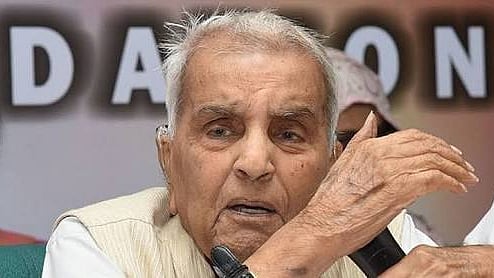Opinion
Remembering late Justice Sachar’s crucial report on status of Muslims
The committee headed by Justice Rajinder Sachar, who passed away on April 20, compiled a 404-page document in 2006 which touched on many important issues related to the Muslim community

Justice Rajinder Sachar, former Chief Justice of the Delhi High Court passed away on April 20, 2018, aged 94. In 2006, a Committee headed by Justice Sachar compiled a 404-page document which touched on many important issues related to the Muslim community. When Justice Sachar submitted his report to the then Prime Minister Manmohan Singh on November 17, 2006, he did not just write one sentence. Yet there are many in this country who believe that the only sentence of any substance written in the Sachar Committee report is: “The condition of Muslims is worse than Dalits”.
The tragedy with the Sachar Committee report is that it has been quoted selectively by various individuals and parties to achieve their own political end. For example, many BJP leaders, who would otherwise accuse the Congress of Muslim appeasement, would sometimes selectively quote from it to highlight the sorry plight of the community. Some scholars, journalists, Muslim leaders and NGOs too would go overboard while analysing the Sachar Committee report.
The great irony with the report is that many people commented on it without even reading it. This phenomenon continues till today. Perhaps, the first ‘culprit’ was an English daily, which did a story before the report was submitted to the PM, claiming that it says that the condition of Muslims is worse than Dalits.
The senior journalist who did the story might have based the report on the basis of the selective inputs from the sources. As the report was not yet public, the said scribe might not have read the voluminous report. No doubt the plight of Muslims is bad and in some cases worse than Dalits. But that would be half-‘sach’ (truth) as Dalits lag far behind Muslims in various other fields.
The task of the Sachar Committee was not to make a comparison between Muslims and Dalits, as it is sometimes misunderstood. In fact, it was asked to study the social, economic and educational status of Muslims in India, based on the 2001 Census, as well as on data provided by NSSO, CSO, Election Commission etc. In the process, it sometimes made comparison with Dalits, OBCs and even the upper caste Hindu population. At some places, comparisons have been made among different religious communities of the country.
Published: undefined
The misfortune with the Sachar Committee report is that many ended up drawing just a one line conclusion, when the fact is that there is much more interesting data and analyses in it. There is no denying the fact that the social, economic and educational status of Muslims is poor. Yet it is also a fact that the report found that on several counts, they are better off than the general population. But these facts from the report were not highlighted
There is no denying the fact that the social, economic and educational status of Muslims is poor. Yet it is also a fact that the report found that on several counts, they are better off than the general population. But these facts from the report were not highlighted.
For instance, Muslims are much better in many health indicators, notwithstanding the fact that the number of government hospitals and clinics in their localities and villages are fewer. In face of all odds, the community has made its own efforts in this regard.
The infant mortality rate among Muslims is 57 out of 1,000 against 77 of Hindus. The child mortality rate of Muslims is 83 per thousand, against 107 of Hindus. As per the Sachar Committee report, Muslims live a year more than Hindus. Though the fertility rate of Muslim women is higher, the maternal mortality rate among Muslims is less than Hindus.
As Dalits get more government attention, their performance in some sectors is slightly better than Muslims in general. Yet in literacy rate Muslims are ahead of Dalits and even some OBCs. As per the 2001 Census, the literacy rate among Muslims was 59.1% against 65.1% of the country. In at least 10 states, the literacy rate among Muslim women was better than the overall figure.
Here one must distinguish between literacy rate and higher education, in which Muslims fare poorly. In the absence of government schools in their localities, the ‘maktabs’ play an important role in making them literate. The school drop-out rate among Muslims is much more than Hindus. This suggests that though Muslims are eager to impart education to their children, they do not continue because of poor economic condition.
The Sachar report tried to objectively analyse the performance of Muslim students in prestigious institutions such as IITs, IIMs and even in Civil Services exams conducted by the Union Public Service Commission (UPSC). A careful look of the result of UPSC 2003-04 presented on Page 168 would be an eye-opener. The percentage of Muslims who passed the Mains and subsequently the Interview after Preliminary Test is exactly the same as that of Hindus. The only problem with Muslims is that the number of those who crack PT is much less. Similarly, the percentage of Muslims cracking GATE for admission in M Tech is higher than that for the B Tech admission test. This is because most Muslims are late starters.
The report also highlighted the self-employment effort made by the community. Besides, remittances also play an important role in keeping the community afloat.
The misfortune with the Sachar Committee report is that many ended up drawing just a one line conclusion, when the fact is that there is much more interesting data and analyses in it.
Published: undefined
Follow us on: Facebook, Twitter, Google News, Instagram
Join our official telegram channel (@nationalherald) and stay updated with the latest headlines
Published: undefined